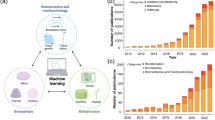Abstract
Determination of potential cytotoxicity is a central issue in current biocompatibility testing standards such as ISO and ASTM. Most of these tests do not assess biocompatibility of a biomaterial with regard to cell function. This study was aimed at screening a number of potential parameters that could be included in assessment of cell functional aspects of biocompatibility. Human umbilical vein endothelial cells (HUVEC) were seeded directly on titanium, NiCr alloy, CoCr alloy, PMMA, PE, PU, PVC, and silicone, or were exposed to the material extracts. Cytotoxicity was assessed for these materials through MTT conversion, crystal violet protein determination and Ki67 expression. In addition, expression of the cell adhesion molecules E-selectin, cadherin-5 and PECAM, as well as of the adhesion-associated proteins fibronectin and vinculin (focal adhesions), was determined by immunocytochemistry and western blotting. Cytotoxicity was not detected with the material extracts. Cells were able to adhere to bare metals, but not polymers. Fibronectin preadsorption resulted in adhesion and spreading also on the polymers. Cells were able to establish cell–cell contacts and focal adhesions. Western blotting, in combination with differential detergent extraction, indicated that linkage of cell–cell adhesion markers to the cytoskeleton may be used as an additional parameter relevant to cell function.
Similar content being viewed by others
References
J. E. DAVIES, Anat. Rec. 245 (1996) 426.
A. E. JAFFE, R. L. NACHMANN, C. G. BECKER and C. R. MINICK, J. Clin. Invest. 52 (1973) 2745.
R. J. GILLIES, N. DIDIER and M. DENTON, Anal. Biochem. 159 (1986) 109.
W. KUENG, E. SILBER and U. EPPENBERGER, ibid. 182 (1989) 16.
M. A. SCRAGG and L. R. FERREIRA, ibid. 198 (1991) 80.
T. GROTH and G. ALTANKOV, J. Biomater. Sci. Polym. Ed. 7 (1995) 297.
G. ALTANKOV, F. GRINNELL and T. GROTH, J. Biomed. Mater. Res. 30 (1996) 385.
S. I. ERTEL, B. D. RATNER, A. KAUL, M. B. SCHWAY and T. A. HORBETT, ibid. 28 (1994) 667.
F. RE, A. ZANETTI, M. SIRONI, N. POLENTARUTTI, L. LANFRANCONE, E. DEJANA and F. COLOTTA, J. Cell. Biol. 127 (1994) 537.
R. C. BATES, L. F. LINCZ and G. F. BURNS, Canc. Metastasis Rev. 14 (1995) 191.
G. SCOTT, L. CASSIDY and A. BUSACCO, J. Invest. Dermatol. 108 (1997) 147.
Author information
Authors and Affiliations
Rights and permissions
About this article
Cite this article
KOOTEN, T.G.V., KLEIN, C.L., KOHLER, H. et al. From cytotoxicity to biocompatibility testing in vitro: cell adhesion molecule expression defines a new set of parameters. Journal of Materials Science: Materials in Medicine 8, 835–841 (1997). https://doi.org/10.1023/A:1018541419055
Issue Date:
DOI: https://doi.org/10.1023/A:1018541419055




